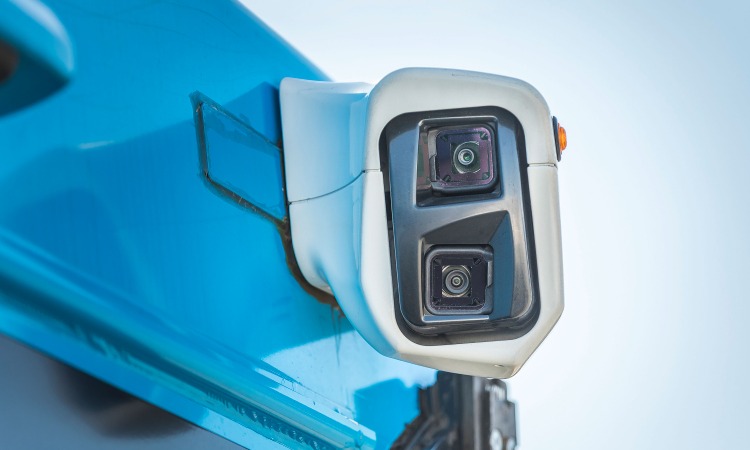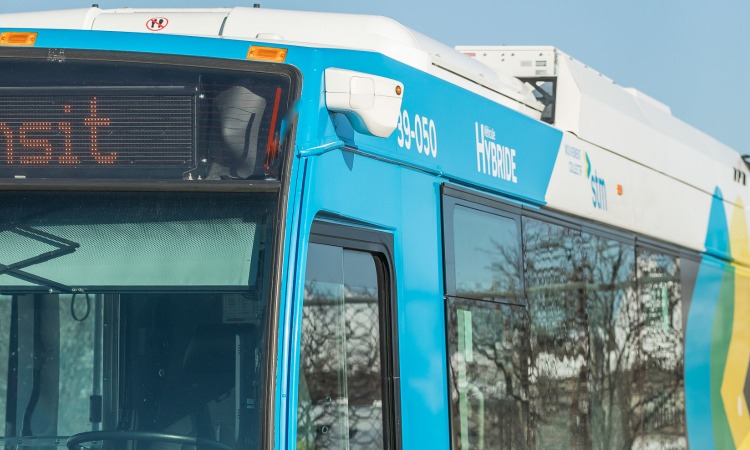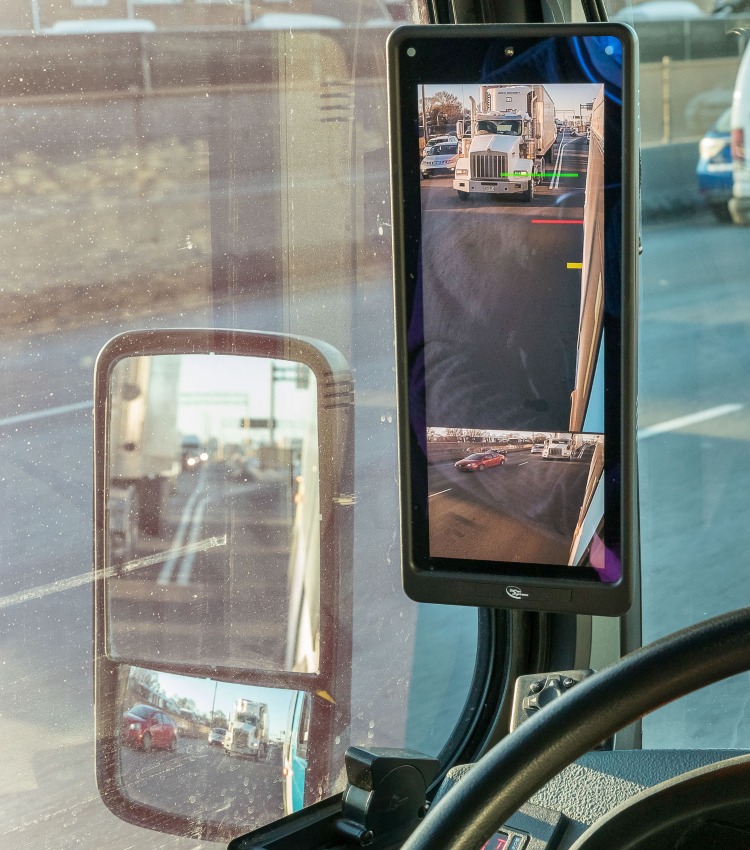Rear-view cameras: Promising technology now road testing in Montréal
- Like
- Digg
- Del
- Tumblr
- VKontakte
- Buffer
- Love This
- Odnoklassniki
- Meneame
- Blogger
- Amazon
- Yahoo Mail
- Gmail
- AOL
- Newsvine
- HackerNews
- Evernote
- MySpace
- Mail.ru
- Viadeo
- Line
- Comments
- Yummly
- SMS
- Viber
- Telegram
- Subscribe
- Skype
- Facebook Messenger
- Kakao
- LiveJournal
- Yammer
- Edgar
- Fintel
- Mix
- Instapaper
- Copy Link
Posted: 29 March 2022 | Pascal Octeau - Société de transport de Montréal | No comments yet
Pascal Octeau, Section Manager – Projects and Tenders, Engineering at the Société de transport de Montréal, discusses the operator’s rear-view camera pilot as road testing trials continue, providing insight into the extensive work and testing that has facilitated the innovative project and highlighting the range of safety benefits that rear-view cameras, in place of rear-view mirrors, provide.


Credit: Société de transport de Montréal
The Société de transport de Montréal (STM), operating in the province of Quebec, is the second-largest transit provider in Canada. Boasting a 71km underground metro, a paratransit service and a bus network that covers over 500km2, with up to 1,400 buses in service during peak periods, STM provides transportation to hundreds of thousands of Montrealers every day.
Boasting a 71km underground metro, a paratransit service and a bus network that covers over 500km2, with up to 1,400 buses in service during peak periods, STM provides transportation to hundreds of thousands of Montrealers every day
Running a bus network in a city like Montréal comes with its fair share of challenges, including the harsh winter weather; variable road conditions; narrow streets requiring precisely calculated turns; a large number of kerbside lamp posts; traffic lights and signposts; and a high density of drivers, cyclists and pedestrians sharing the road and sidewalks.
Amid these conditions, rear-view side mirrors are vital tools for bus drivers. It is, therefore, no surprise that they have been the subject of an ongoing examination and improvement process led by the STM bus engineering team, in collaboration with several other sectors of the operations and maintenance departments. This process is what led to the current pilot project that is testing rear-view camera systems.
The limitations of standard side mirrors
The main goal of this project is to facilitate safe driving and to improve overall safety for all road users in accordance with the City of Montréal’s participation in ‘Vision Zero’, which calls for zero deaths and serious injuries on the road, while also improving equipment durability and reliability.
The main goal of this project is to facilitate safe driving and to improve overall safety for all road users in accordance with the City of Montréal’s participation in ‘Vision Zero’
Despite adjustments to optimise placement and reduce size, side mirrors still require frequent replacement. Each year, STM replaces roughly 3,500 rear-view mirrors, causing buses to be stopped mid-service or towed to bus garages – impacting the quality of service for customers. While these replacements are indeed on the decline, side mirrors can still cause accidents involving pedestrians, a risk that is all but eliminated when the much more compact and higher-placed rear-view cameras are used. The cameras also greatly reduce the size of blind spots compared to regular side mirrors.
Wanting to bring our equipment in line with best practices from European and Asian countries, STM has begun testing rear-view camera systems under the real-world operating conditions of Montréal. This major project was realised through the combined and considerable efforts of many parties, including the departments of training, road safety and bus engineering, operations and maintenance, as well as the bus drivers’ union.


Credit: Société de transport de Montréal – Cameras are placed higher up and are more compact and durable, reducing potential damage from collisions with objects or pedestrians.
Pilot project implementation
The project began before the pandemic with a process of testing, validating and fine-tuning the cameras under different operating conditions. Two buses were equipped with the systems, which include side cameras displaying images on dual screens inside the driver’s compartment. The screens are placed to the left and right of the windshield, allowing drivers to maintain their visual scanning habits at the wheel – making it easier to transition from buses with regular rear-view mirrors to ones with cameras. The system is easy to use and requires minimal training.
In this new phase of testing, STM aims to assess the system’s performance under different conditions to ensure the cameras’ durability and reliability, as well as to collect feedback on driver satisfaction and ease of use. The first tests were conducted by the engineering and road safety teams and by members of the drivers’ union. Their expert comments and recommendations were collected, shaping the project from the earliest stages to increase the chance of success of the next stages.
The importance of road tests
Because the two test buses are actually in service and being driven all day, the camera systems will be in use for many more hours, providing better long-term data on their durability and reliability. The systems are also subjected to real-world driving conditions for more in-depth testing. It is also important to consider how long drivers will take to familiarise themselves with the new system and how easily they will be able to switch between it and regular rear-view mirrors. For now, a two-hour training period is planned. Each driver testing out the system will also be asked to complete a survey, and the results will be compiled and included in the engineering team’s final report.
Results to date
Rear-view cameras do provide the expected benefits, particularly in terms of improved visibility in various challenging lighting situations
Road tests with customers on board are progressing well since starting in early winter 2021, and the driver feedback received so far has been very positive. The results have been in line with what was observed in previous stages of the project – the rear-view cameras do provide the expected benefits, particularly in terms of improved visibility in various challenging lighting situations, such as tunnels, night driving, snow and glare from the sun. Drivers are also pleased with the improved field of vision and reduced blind spots during turns.
The cost of one pair of rear-view side mirrors is roughly $1,800, while a full rear-view camera system represents an investment of approximately $14,000. Although one cannot put a price on better road safety, this is a significant cost that must be taken into consideration. In the long term, however, the camera system’s durability and reliability, combined with the expected reduction in repairs or replacements due to accidents, must also factor into the equation.
Another expected benefit is the sustainability of the system. Every day, buses have to be taken out of service and returned to the garage because of rear-view mirrors that have broken in collisions. It stands to reason that replacing the mirrors with these more compact and sturdier cameras will keep buses on the road longer. STM also plans to assess whether long-term savings could potentially be achieved, given the system’s expected life span.


Credit: Société de transport de Montréal – Colour-coded lines were added as visual markers to help drivers gauge distance and perspective.
Learning and improvement
During initial testing without customers, STM teams made a number of improvements to the rear-view cameras and screens before putting the vehicles back into service. One problem that they encountered was that the heating element used to defog the camera lens did not hold up against built-up snow and ice while driving, nor did it prevent the appearance of dried water marks when the bus was washed. To remedy the situation, STM engineers designed a sophisticated device that keeps the camera lenses clean by using the pneumatic system, already present on all STM buses, to direct a jet of forced air into the camera lens. The device can be activated automatically or on demand, at the touch of a button on the driver’s dashboard.
STM collaborated with the system supplier to add visual markers to the screens… this makes it easier to gauge distances between objects or vehicles on the road
Test drivers also commented that it was difficult to accurately judge distances and perspective when looking at the screens, compared to side mirrors. In response, STM collaborated with the system supplier to add visual markers to the screens. Now, when the driver uses the turn signal or starts to back up, the following-coloured lines appear:
- Yellow: centre of the back wheels
- Red: end of the back bumper
- Green: clearance point from the vehicle behind.
This makes it easier to gauge distances between objects or vehicles on the road.
In the interest of safety, the system also checks constantly to ensure that there is no delay in the image from camera to screen. In the event of a delay as short as a millisecond, the feed will cut and display an error message. This immediately alerts the driver, who can then pull over and perform the necessary troubleshooting. If the problem persists, then the standard repair or replacement procedure applies. In the medium- and long-term, a preventive and remedial maintenance schedule will have to be set if the cameras become more widely used in the STM bus fleet.
Ensuring regulatory compliance
Rear-view camera systems are rarely used on public transit vehicles in North America, so it is important to consider all legal and regulatory factors before implementing them, even on a limited number of vehicles. Before beginning road tests, STM had to submit a report based on its initial closed-course testing to the Société de l’assurance automobile du Québec (SAAQ), the regulatory body for motor vehicles in Quebec, and be granted an exemption. This authorised STM to begin testing without customers and, once conclusive results had been obtained, to apply for another exemption to begin serving customers with the two buses.
Once the pilot project is over, STM will also submit a complete testing report to SAAQ. The report will be considered when SAAQ decides whether to authorise rear-view camera systems for vehicles currently in use. In November 2021, this type of system was authorised for certain Canadian city bus suppliers by Transport Canada, the federal institution that regulates new vehicles.
Modernising the surface network
The rear-view camera pilot project is a promising endeavour that has brought together the innovative talents of multiple teams to solve real‑world problems
The rear-view camera pilot project is a promising endeavour that has brought together the innovative talents of multiple teams to solve real‑world problems directly relevant to the City of Montréal’s Vision Zero action plan. The test results and analysis will help STM to better evaluate the possibility of installing rear-view cameras on its current and future vehicles, while also ensuring that the company is properly prepared to do so.
With the bus electrification project well underway, this is another action that STM is taking to modernise its bus network and continue innovating to provide better, safer and more efficient service.
Pascal Octeau is a Unified Engineering graduate of the Université du Québec à Chicoutimi (’88) with more than 33 years of experience. For over 17 years, he has been the Manager of the Projects and Tender group of STM’s Bus Engineering division. His group is responsible for the research, development and monitoring of new ground transportation technologies, such as: specialised vehicles; electric and hybrid buses; and paratransit. Previously, for 12 years, he was a Research & Development Officer at CRIQ (Quebec Industrial Research Center) in the field of fatigue testing in land transport, advanced electronics and complex structures.
Related topics
Fleet Management & Maintenance, Passenger Experience, Public Transport, Vehicle & Passenger Safety
Issue
Issue 1 2022
Related modes
Bus & Coach
Related cities
Montreal
Related countries
Canada
Related organisations
Société de Transport de Montréal (STM)
Related people
Pascal Octeau







